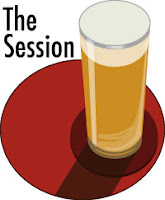That's all the e-mail said, but I could see it came from the company which does PR for Heineken Ireland. I like surprises so I gave them my address without asking further questions. A couple of hours later a parcel arrived containing eight half-litre cans of Coors Light. My lucky day. Less than a month out of the brewery, too. It wasn't just a random gift, however: they were promoting a gewgaw which comes free with sufficient purchase of the beer. This affixes to the bottom of the can, keeping it extra-cold while it's being consumed. From, presumably, the can itself. Swish.
While all this is outside the regular programming at The Beer Nut, I don't actually have a review of Coors Light here. Not that I've never tasted it; indeed I stumbled into the official launch of the draught version back in the summer of 2000. It was in Dakota on South William Street. There was an ice sculpture. Anyway, here I am with four litres of a beer I've never reviewed so it would only be proper to do some experimentation.
 First, to give it the treatment every beer gets. The first can was kept in my beer fridge at 10°C. As the picture shows, the can is "cold", but not "Rocky Mountain cold". It's a very pale yellow and there's masses of fizz. The head subsides most of the way but a thin white mousse remains, constantly topped up by the busy bubbles. The aroma offers an odd mix of tin and ripe apples. That sweet fruit thing is the opening flavour but it disappears quickly, replaced by... nothing. There's a huge void right where you'd expect the main part of the taste to be. It's not watery -- the texture is actually quite slick and heavy -- but no identifiable malt elements and certainly not even a whimper from the hops. There's maybe just a tiny metallic buzz on the side of the tongue. Boring beats awful every time, but I really didn't think it would be hard to find things to say about this beer. Quite an achievement of the brewer's art.
First, to give it the treatment every beer gets. The first can was kept in my beer fridge at 10°C. As the picture shows, the can is "cold", but not "Rocky Mountain cold". It's a very pale yellow and there's masses of fizz. The head subsides most of the way but a thin white mousse remains, constantly topped up by the busy bubbles. The aroma offers an odd mix of tin and ripe apples. That sweet fruit thing is the opening flavour but it disappears quickly, replaced by... nothing. There's a huge void right where you'd expect the main part of the taste to be. It's not watery -- the texture is actually quite slick and heavy -- but no identifiable malt elements and certainly not even a whimper from the hops. There's maybe just a tiny metallic buzz on the side of the tongue. Boring beats awful every time, but I really didn't think it would be hard to find things to say about this beer. Quite an achievement of the brewer's art. So if it's this bland at serving temperature, what's the point of having it cold? To find out, I stuck a can in the freezer to earn that extra blue stripe, and I froze a mug as well, for good measure. Served this way, it's cold. It burns. It feels almost flat, which I guess is an unintended consequence of the solubility of CO2 at low temperatures. The slickness is even more apparent, though is perhaps more of an icy slipperiness now. The appley fruit is almost gone but there's still a bit of a tang from the metal. The glass contents disappeared quite quickly and thoughtlessly: the beer equivalent of popcorn. Plain, unbuttered, unsalted popcorn. The cans left after this experiment will likely be put to use in this way, with the Saturday night curry.
So if it's this bland at serving temperature, what's the point of having it cold? To find out, I stuck a can in the freezer to earn that extra blue stripe, and I froze a mug as well, for good measure. Served this way, it's cold. It burns. It feels almost flat, which I guess is an unintended consequence of the solubility of CO2 at low temperatures. The slickness is even more apparent, though is perhaps more of an icy slipperiness now. The appley fruit is almost gone but there's still a bit of a tang from the metal. The glass contents disappeared quite quickly and thoughtlessly: the beer equivalent of popcorn. Plain, unbuttered, unsalted popcorn. The cans left after this experiment will likely be put to use in this way, with the Saturday night curry.
So much for the drinker's preference. How does this beer stand up served the way the PR company intended? I reached for the gewgaw -- a "Chill Puck" to give it its proper name in scare quotes -- frozen per the instructions, and dutifully affixed it to the can. It's just as flat consumed this way, and tastes exactly the same. The most annoying thing about drinking straight from a frozen can is how cold it it is to touch -- a handled mug is definitely the way to go if very cold beer is what you're after. Whether the device does actually help keep the second blue stripe lit for longer is not something I can confirm or deny in this limited experiment which didn't involve drinking an unadorned can, but it seems likely that it performs some sort of service, the thing itself remaining completely cold to the touch throughout proceedings.
It's easy to scoff at beers like Coors Light. It's fun too.







































